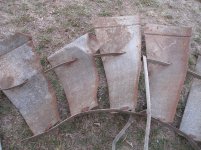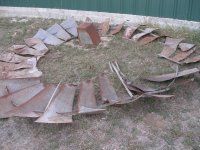Thanks to all for replying with all your suggestions. I hope the pics of the windmill uploaded, if not I'll try again.
Many focused on the metal stretching if I pound and I don't quite understand why I'd care. The fan blades are not high precision with precise joints so who cares if the blades stretch out a bit ?
Interesting technique about shrinking with heat, causing me to look on YouTube and elsewhere and I found some interesting additional information. One idea, though slower, is let it cool naturally so as to not require hardening and annealing. One other suggestion was to cool with compressed air.
As to just buying new blades for $20 each, there are 30 in a 10 foot wheel so its out of the question.
BTW I found that Harbor Freight has a 3 hammer and dolly set for $40 so I'm going to try that. Not high quality but good enough for my purpose. I also found the technique interesting to drive over the blades in sand and will try it.
Farmerford, sorry I'm a rookie so I don't know about Flute and Walling parts (yet) but will let you know if I find something. I see you've discovered the wealth of info and sources on the internet, so keep trying. It seems Aermotor and Dempster are the two biggies and still in business though at one time I understand there were 1000 manufacturers.
And lastly, does anyone have a good technique for removing non hollow, e.g. steel rivets (beside drilling them out) holding the blades onto the frames ? I've got about 200 to do. Best suggestion I've seen so far is to try grinding one side of the rivet and punching them out. Or if you have to drill, using a countersink high speed bit, some oil, and maybe just try to drill off the head and punch it out.
Thanks for all suggestions and help. I'm taking a blade to a metal man tomorrow to see if he can do any good cost effectively...
Bob

